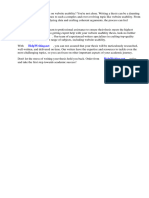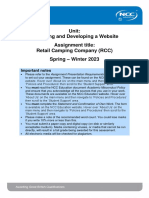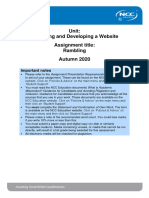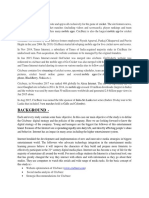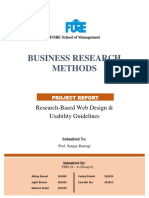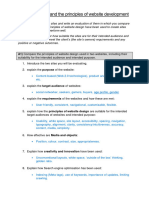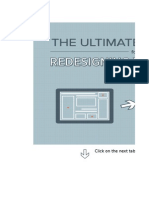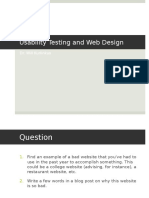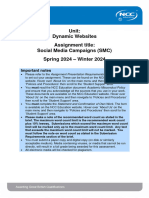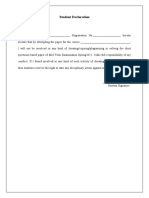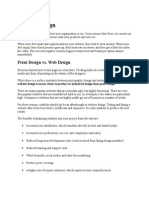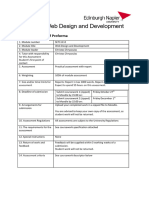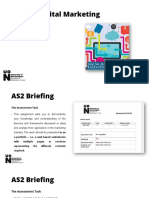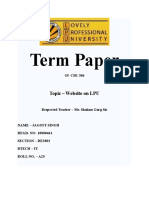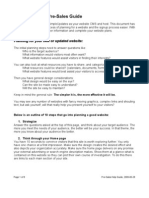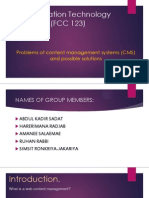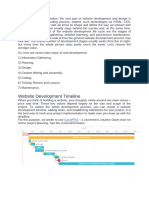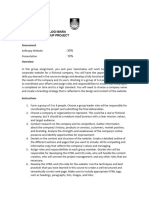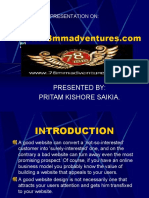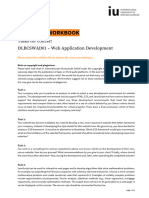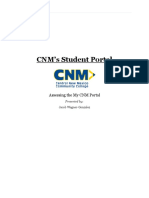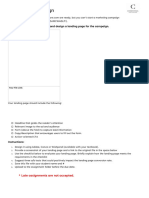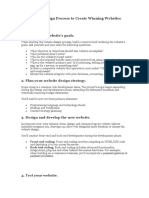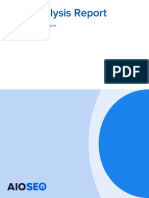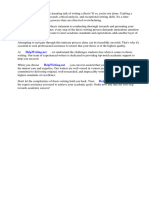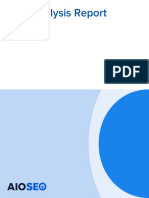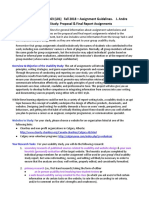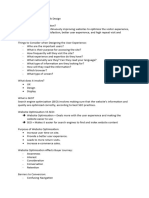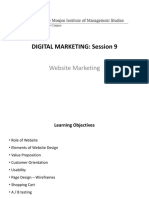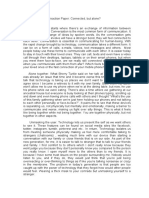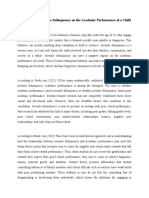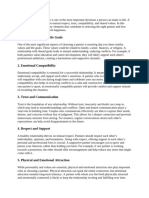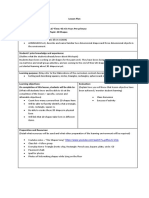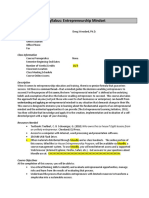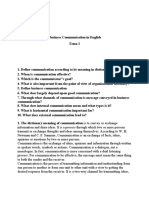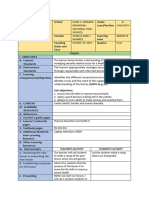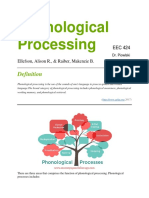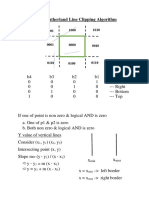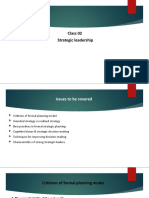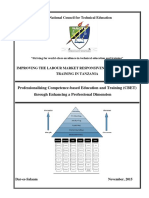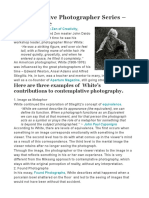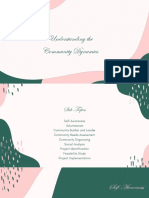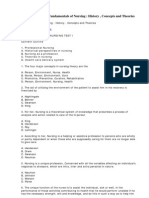Essay #5: Justifying An Evaluation: For Education Professionals.)
Essay #5: Justifying An Evaluation: For Education Professionals.)
Uploaded by
Mia RendonCopyright:
Available Formats
Essay #5: Justifying An Evaluation: For Education Professionals.)
Essay #5: Justifying An Evaluation: For Education Professionals.)
Uploaded by
Mia RendonOriginal Title
Copyright
Available Formats
Share this document
Did you find this document useful?
Is this content inappropriate?
Copyright:
Available Formats
Essay #5: Justifying An Evaluation: For Education Professionals.)
Essay #5: Justifying An Evaluation: For Education Professionals.)
Uploaded by
Mia RendonCopyright:
Available Formats
English 111
Erin Dietel-McLaughlin
Essay #5: Justifying an Evaluation
Overview
Have you ever discouraged a friend from going to a popular restaurant, citing the slow service and
high prices? Perhaps you decided against purchasing an item once you realized it didn’t meet your
specifications? In day-to-day life, we frequently make these kinds of evaluations. Evaluation will
also be an important skill during your college and teaching careers: there will be occasions when
you will need to evaluate texts and other materials, supporting those evaluations with well-
developed, well-supported, and convincing analyses. It’s important in these types of tasks to
establish a clear set of standards for your evaluation and to support your judgments with reasons,
evidence, and examples.
Audience and Purpose
The scenario: BGSU is planning to publish a “Best of the Web” list, and a select few BGSU students
from each degree program have been asked to make recommendations for which sites should be
included on the list. Your job is to evaluate one Web site that you think would be of interest of
other BGSU students in your degree program to help the editors of the “Best of” list decide if the
site should or should not be included on their list.
Your goal here is to come up with criteria that make a good Web site and then apply those criteria
to the site you are evaluating. You may choose any criteria that you feel are important features of
a quality site, including (but not limited to): visual design, ease of use/navigation, clarity of
written content, interactivity, currency of information, credibility of information, usefulness,
unbiased point of view, quick loading time, etc.
Requirements
Your essay should be around four full pages in length, in MLA format. You are not required to use
sources for this paper, other than the site itself – please include a printed copy or screen capture of
the site with your paper (this does not count toward total page length).
Suggestions for organizing this paper:
1) Start with an engaging introduction. You will want to identify the name of site, the
individual or organization sponsoring the site, and include a thesis that gives your overall
evaluation and preview of the criteria that you used to reach that evaluation. If your site
does well on some criteria and not-so-well on others, consider using a “weighted” thesis (for
example: Although it is at times difficult to navigate, the stunning graphics, currency of
information, and quality content offered by EduHound.com make it an excellent Web site
for education professionals.)
2) Three or four “reason” paragraphs. Each of these paragraphs should 1) introduce one of
your criterion, 2) explain why that criterion is important in a quality Web site, 3) give
evidence from the site you are evaluating to which you can apply the criterion, and 4) offer
a concluding judgment of the evidence based on the criterion you’ve chosen. Please focus
on one criterion per paragraph.
3) A paragraph that introduces, explains, and refutes or accommodates a counterargument.
Here are some possibilities for counterarguments:
a. If your overall evaluation of the site is positive, your CA would address the
drawbacks of the site. In the case of the weighted thesis listed above, for example,
your CA would discuss the difficult navigation and would then respond by showing
Partially adapted from Westrick and Messenger
English 111
Erin Dietel-McLaughlin
how the other criteria are important enough to outweigh this negative aspect.
Similarly, if the overall evaluation of the site is negative, then your CA would address
any positive aspects of the site.
b. If the site performed the same way on ALL of your criteria, your CA would then
address those who might think an important criterion (that might change the results)
was left out of your evaluation (for example: “Some might argue that flashy, blinking
graphics should be considered an important criterion for a quality Web site, and it’s
true that such graphics do capture the attention of viewers. Mysiterocks.com
performs well in this area, employing several flashing banners and animated graphics
that could conceivably entertain and delight site visitors. However, such graphics
are often more distracting than they are enticing, and no amount of flashy animation
can ever make up for a lack in content, poor navigation structure, and inconsistent
design. Poor performance on these criteria clearly outweighs any small gain offered
by flashy graphics”).
4) A conclusion that reiterates your thesis – the overall evaluation of the review’s quality and
effectiveness – in a memorable and satisfying way. This is your last chance to convince the
editors to include or not include this site in their publication.
Usage Note:
1) criterion = singular (“Another feature that makes Mysite.com an excellent site for educators is its
up-to-date information. This criterion is important because….”)
2) criteria = plural (“Ultimately, Mysite.com should not be included in the upcoming “Best of the Web”
publication because the site lacks credibility, it is difficult to navigate, and it does not offer any
useful educational features. These criteria are important to today’s educators and therefore…..”)
How to include a screen capture (optional):
1) When you are at the page you want to capture, press the “Print Screen” key on your keyboard. The
location of this key will vary depending on your computer model, but it’s likely above the numbers on
your keyboard.
2) Move to your Word document, and place your cursor on the line where you want to insert your screen
capture. Go to the “Edit” menu and select “Paste.” You may then resize the image accordingly.
Keep up the great work – you’re almost done!
Partially adapted from Westrick and Messenger
You might also like
- PST Documentation of Planning Cycle TemplateDocument3 pagesPST Documentation of Planning Cycle TemplateAnh Pham QuynhNo ratings yet
- OpenStax Psychology2e LN12Document12 pagesOpenStax Psychology2e LN12Shehib GulaimidNo ratings yet
- Web Usability Literature ReviewDocument7 pagesWeb Usability Literature Reviewc5qz47sm100% (1)
- Website Usability ThesisDocument8 pagesWebsite Usability Thesisbeacbpxff100% (1)
- Web Usability DissertationDocument7 pagesWeb Usability DissertationWhitePaperWritingServicesCanada100% (1)
- Usability Testing and Web Design: Dr. Will KurlinkusDocument17 pagesUsability Testing and Web Design: Dr. Will KurlinkusWill KurlinkusNo ratings yet
- DDW Assignment Spring 2024 - Winter 2024 (6751)Document6 pagesDDW Assignment Spring 2024 - Winter 2024 (6751)Kennedy Bernardo PhiriNo ratings yet
- DDW Spring Winter 2023 Assignment QP FINALDocument6 pagesDDW Spring Winter 2023 Assignment QP FINALIbrahimNo ratings yet
- DDW Assignment Spring 2024 - Winter 2024 (6751)Document6 pagesDDW Assignment Spring 2024 - Winter 2024 (6751)sajjadmunshi99No ratings yet
- Unit: Designing and Developing A Website Assignment Title: Rambling Autumn 2020Document5 pagesUnit: Designing and Developing A Website Assignment Title: Rambling Autumn 2020FatsaniNo ratings yet
- Background: Cricbuzz Is A SportsDocument16 pagesBackground: Cricbuzz Is A SportsSabyasachi SarkerNo ratings yet
- A Beginner - S Guide To Conversion Rate OptimizationDocument8 pagesA Beginner - S Guide To Conversion Rate OptimizationAtul BendaleNo ratings yet
- Lab ManualDocument68 pagesLab ManualRutuja SawantNo ratings yet
- Business Research Methods: Research-Based Web Design & Usability GuidelinesDocument19 pagesBusiness Research Methods: Research-Based Web Design & Usability GuidelinesSaurabh JhaNo ratings yet
- Unit 6 - Task A Help SheetDocument2 pagesUnit 6 - Task A Help SheetAlbert guoNo ratings yet
- DDW Assignment QP Spring Winter 2022 FINAL (Update)Document5 pagesDDW Assignment QP Spring Winter 2022 FINAL (Update)Myint Hlaing SanNo ratings yet
- Website Development Process - Full Guide in 7 StepsDocument8 pagesWebsite Development Process - Full Guide in 7 StepsJeremie mbring100% (1)
- Website Redesign WorkbookDocument49 pagesWebsite Redesign WorkbookIanosi Mihai0% (2)
- Us Ability Test 1Document14 pagesUs Ability Test 1Will KurlinkusNo ratings yet
- Wa0006.Document5 pagesWa0006.mickycrealNo ratings yet
- Web Enginering MiidDocument12 pagesWeb Enginering Miidcaty farousNo ratings yet
- Website Planning PrintDocument22 pagesWebsite Planning Printmohd sapuan mohamad saleh100% (2)
- Web Developer Interview Questions AnswersDocument27 pagesWeb Developer Interview Questions AnswersAbdul Samad Malik100% (1)
- Usability of A WebsiteDocument3 pagesUsability of A WebsiteBabuKumarNo ratings yet
- Answers ReviewDocument34 pagesAnswers ReviewRicardo Barros50% (2)
- Food Delivery OrignalDocument6 pagesFood Delivery OrignalsyedshanNo ratings yet
- Joe GoldbergrevisedwebsiteevalDocument11 pagesJoe Goldbergrevisedwebsiteevalapi-463548515No ratings yet
- Mining The Web For Design Guidelines: Marti Hearst, Melody Ivory, Rashmi Sinha UC BerkeleyDocument52 pagesMining The Web For Design Guidelines: Marti Hearst, Melody Ivory, Rashmi Sinha UC BerkeleyZuhdijaNo ratings yet
- MKT3039 - Week Nine Workshop - AS2 BriefingDocument15 pagesMKT3039 - Week Nine Workshop - AS2 BriefingNguyễn Phạm Ngọc TrâmNo ratings yet
- Hci Framework 1Document6 pagesHci Framework 1Vamshi KrishnaNo ratings yet
- Term Paper WebDocument9 pagesTerm Paper WebPrince SrivastavaNo ratings yet
- Assignment 2Document6 pagesAssignment 2l1111c1anh-5No ratings yet
- Usability in DesignDocument24 pagesUsability in DesignAgha KazimNo ratings yet
- Presales Help GuideDocument8 pagesPresales Help GuidesamNo ratings yet
- Web Content ManagementDocument14 pagesWeb Content ManagementZakaria Haroon0% (1)
- Steps in Developing WebsiteDocument6 pagesSteps in Developing Websitevanshthakral2004No ratings yet
- Website Redesign Guide How To Transform Your WebsiteDocument15 pagesWebsite Redesign Guide How To Transform Your WebsiteJackie Nguyen100% (1)
- Thesis Supervisor ReportDocument7 pagesThesis Supervisor ReportBestPaperWritingServiceUK100% (1)
- GUIDELINE IMD318 - 2024 - GroupDocument2 pagesGUIDELINE IMD318 - 2024 - GroupAin FdNo ratings yet
- Criteria S For WebsitesDocument4 pagesCriteria S For Websites47 Phan Thị Ái TiênNo ratings yet
- TestingDocument12 pagesTestingJamie HowellNo ratings yet
- Presented By: Pritam Kishore Saikia.: Presentation OnDocument32 pagesPresented By: Pritam Kishore Saikia.: Presentation Onpritam0987No ratings yet
- Httpsmycampus - Iubh.depluginfile - Php334010mod Resourcecontent2Task Advanced20Workbook DLBCSWAD01 1.pdfforcedownload 1 2Document2 pagesHttpsmycampus - Iubh.depluginfile - Php334010mod Resourcecontent2Task Advanced20Workbook DLBCSWAD01 1.pdfforcedownload 1 2rajathffidNo ratings yet
- Cloud Database Architectures A Clear and Concise ReferenceFrom EverandCloud Database Architectures A Clear and Concise ReferenceNo ratings yet
- Carrier Network Infrastructure CNI The Ultimate Step-By-Step GuideFrom EverandCarrier Network Infrastructure CNI The Ultimate Step-By-Step GuideNo ratings yet
- Site reliability engineering A Clear and Concise ReferenceFrom EverandSite reliability engineering A Clear and Concise ReferenceNo ratings yet
- Multimedia WebsiteDocument26 pagesMultimedia WebsiteSylvaen WswNo ratings yet
- CNM's Student PortalDocument9 pagesCNM's Student Portalapi-332415256No ratings yet
- W9 Landing Page DesignDocument6 pagesW9 Landing Page DesignHooria ZiaNo ratings yet
- 5 Step WebsiteDocument2 pages5 Step Websitekazoo zabooNo ratings yet
- Aioseo MirrorsacademyinDocument11 pagesAioseo MirrorsacademyinSenthil KumarNo ratings yet
- Thesis Client Site LicenseDocument7 pagesThesis Client Site LicenseCollegePaperGhostWriterSterlingHeights100% (4)
- Aioseo 99visionstudiocomDocument11 pagesAioseo 99visionstudiocomsumbalranarajputNo ratings yet
- Mar 12 DipuidreportDocument10 pagesMar 12 DipuidreportNadeem RazaNo ratings yet
- Usability Proposal Assignment GuidelinesDocument5 pagesUsability Proposal Assignment GuidelinesAditi DwibediNo ratings yet
- L6a Web Optimisation and Web DesignDocument4 pagesL6a Web Optimisation and Web DesignvivianNo ratings yet
- Session 9 - Website Marketing PDFDocument56 pagesSession 9 - Website Marketing PDFshagun jalanNo ratings yet
- Emotions and Learning: by Reinhard PekrunDocument32 pagesEmotions and Learning: by Reinhard PekrunTijana VukovićNo ratings yet
- Reaction PaperDocument2 pagesReaction PaperAlexandriteNo ratings yet
- Communication Theory OutlineDocument5 pagesCommunication Theory OutlineAmratHaqNo ratings yet
- History of Guidance MovementDocument8 pagesHistory of Guidance MovementFroilan FerrerNo ratings yet
- MYP Personal Project GuideDocument35 pagesMYP Personal Project Guidealfonso_cisneros_14100% (2)
- Juvenile Academics RationaleDocument3 pagesJuvenile Academics RationaleJovina Castillon DimacaleNo ratings yet
- Least Learned Skills - 3rd QuarterDocument4 pagesLeast Learned Skills - 3rd QuarterJeffre Abarracoso100% (5)
- Format. Hum - Attitude Towards The Use of Information Technology in Teaching Learning Process Among Student TeachersDocument8 pagesFormat. Hum - Attitude Towards The Use of Information Technology in Teaching Learning Process Among Student TeachersImpact JournalsNo ratings yet
- Art Lesson PlanDocument4 pagesArt Lesson Planapi-280782218No ratings yet
- Perfect PartnerDocument2 pagesPerfect PartnerCassidyNo ratings yet
- Val 9 LP 3 2ND QT - T.MGDocument5 pagesVal 9 LP 3 2ND QT - T.MGCher MGNo ratings yet
- Whole Class Lesson PlanDocument4 pagesWhole Class Lesson Planapi-372387144No ratings yet
- Incentive ProgramDocument3 pagesIncentive ProgramRahmat HariNo ratings yet
- Lesson Plan in Oral Com 1.6Document3 pagesLesson Plan in Oral Com 1.6Jevie Gibertas67% (3)
- E 972587Document6 pagesE 972587Sally Consumo KongNo ratings yet
- Educational ResearchDocument7 pagesEducational ResearchrudisuyantoNo ratings yet
- Business Communication in EnglishDocument20 pagesBusiness Communication in EnglishAndriesNo ratings yet
- DETAILED LESSON PLAN in Life SkillsDocument6 pagesDETAILED LESSON PLAN in Life SkillsRica Claire SerqueñaNo ratings yet
- Thesis Scarf Tracking Sheet FinalDocument2 pagesThesis Scarf Tracking Sheet Finalapi-516570361No ratings yet
- Lecture-Notes-Consumer-Behaviour-Chapter-1-5 NEWWWDocument33 pagesLecture-Notes-Consumer-Behaviour-Chapter-1-5 NEWWWSao Nguyễn ToànNo ratings yet
- Phonological Processing Eec 424Document6 pagesPhonological Processing Eec 424api-375196264No ratings yet
- Cohen-Sutherland Line Clipping AlgorithmDocument6 pagesCohen-Sutherland Line Clipping AlgorithmSiddhartha B S100% (1)
- Teaching FCC To Psych - FullDocument9 pagesTeaching FCC To Psych - FullStgo NdNo ratings yet
- Class 02 Strategic LeadershipDocument9 pagesClass 02 Strategic LeadershipMd. Real MiahNo ratings yet
- CbetDocument21 pagesCbetManfred GithinjiNo ratings yet
- Minor White & ContemplationDocument2 pagesMinor White & ContemplationStuart OringNo ratings yet
- Understanding The Community DynamicsDocument26 pagesUnderstanding The Community DynamicsViernice DeleonNo ratings yet
- Fundamentals of Nursing (5) - 100 Items - QuestionsDocument14 pagesFundamentals of Nursing (5) - 100 Items - QuestionsmikErlhNo ratings yet



